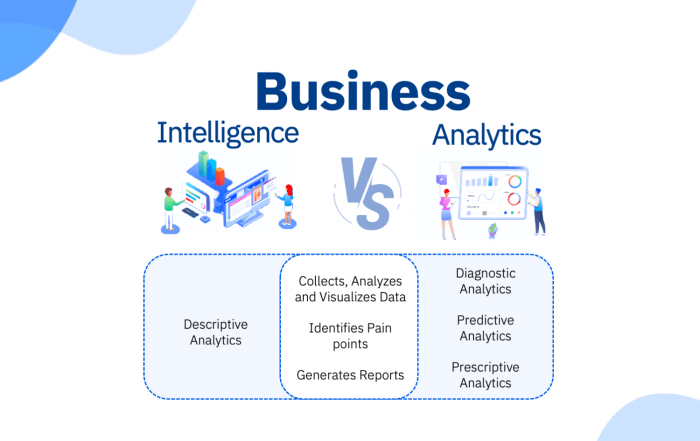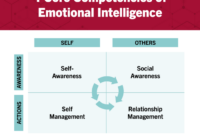Data analytics vs business intelligence – Data analytics and business intelligence: two terms often used interchangeably, yet they hold distinct meanings. This article delves into the differences between these two fields, exploring their methodologies, applications, and career paths to provide a comprehensive understanding of their roles in data-driven decision-making.
While data analytics focuses on extracting insights from raw data, business intelligence leverages these insights to inform strategic decision-making. Together, they form a powerful duo that empowers businesses to harness the full potential of their data.
Overview
Data analytics and business intelligence are two closely related but distinct fields that use data to help businesses make better decisions. Data analytics is the process of collecting, cleaning, and analyzing data to extract meaningful insights. Business intelligence is the process of using data to make informed decisions about a business’s operations.
The following table compares the key differences between data analytics and business intelligence:
| Data Analytics | Business Intelligence | |
|---|---|---|
| Purpose | Extract insights from data | Make informed decisions |
| Data sources | Internal and external data | Primarily internal data |
| Analysis techniques | Statistical analysis, machine learning | Descriptive and predictive analytics |
| Output | Insights, models, predictions | Reports, dashboards, visualizations |
Data Collection and Analysis
Data collection is the first step in both data analytics and business intelligence. Data can be collected from a variety of sources, including internal data sources such as CRM systems and ERP systems, and external data sources such as social media and market research reports.

Once data has been collected, it must be cleaned and prepared for analysis. This involves removing duplicate data, correcting errors, and normalizing the data so that it can be compared and analyzed.
Data analytics and business intelligence are both important for businesses, but they serve different purposes. Data analytics is the process of collecting, cleaning, and analyzing data to find patterns and trends. Business intelligence is the process of using data to make informed decisions.
If you’re looking for a tool to help you compare different business intelligence software, I recommend checking out this comparison. It provides a detailed overview of the features and benefits of each software, so you can make an informed decision about which one is right for your business.
Ultimately, the best way to decide which tool is right for you is to compare data analytics vs business intelligence and see which one meets your specific needs.
Data analysis is the process of using statistical and machine learning techniques to extract meaningful insights from data. Data analysis can be used to identify trends, patterns, and relationships in data. It can also be used to develop predictive models that can be used to make informed decisions about the future.
Data Visualization and Reporting
Data visualization is an important part of both data analytics and business intelligence. Data visualization allows users to quickly and easily understand the results of data analysis. There are a variety of data visualization techniques, including charts, graphs, and maps.
Reporting is another important part of both data analytics and business intelligence. Reports are used to communicate the results of data analysis to stakeholders. Reports can be used to provide insights into a business’s performance, identify opportunities for improvement, and make informed decisions.
Business Applications, Data analytics vs business intelligence
Data analytics and business intelligence have a wide range of business applications. Data analytics can be used to improve customer segmentation, identify new marketing opportunities, and optimize pricing. Business intelligence can be used to improve financial planning, supply chain management, and risk management.
Data analytics and business intelligence (BI) are often used interchangeably, but there’s a key difference. BI focuses on providing insights from historical data, while data analytics can also predict future outcomes. For example, business intelligence dashboard examples can show you how many sales you made last month, while data analytics can help you predict how many sales you’ll make next month.
This distinction is important because it helps you choose the right tool for the job.
Here are some case studies demonstrating how data analytics and business intelligence have been successfully implemented in different industries:
- Retail: Walmart uses data analytics to identify customer trends and optimize its pricing strategy.
- Manufacturing: General Electric uses data analytics to predict equipment failures and improve maintenance scheduling.
- Healthcare: The Mayo Clinic uses data analytics to identify patients at risk for developing certain diseases and develop personalized treatment plans.
Career Paths and Skills
There are a variety of career paths available in data analytics and business intelligence. Data analysts typically have a background in statistics, computer science, or business. Business intelligence professionals typically have a background in business, finance, or economics.
The following are some of the essential skills for success in data analytics and business intelligence:
- Technical skills: Data analytics and business intelligence professionals need to have strong technical skills, including data analysis, data visualization, and programming.
- Business skills: Data analytics and business intelligence professionals need to have a strong understanding of business principles and practices.
- Communication skills: Data analytics and business intelligence professionals need to be able to communicate their findings clearly and effectively to stakeholders.
Future Trends

Data analytics and business intelligence are rapidly evolving fields. Emerging trends in these fields include the use of artificial intelligence and machine learning. Artificial intelligence and machine learning can be used to automate data analysis tasks and develop more accurate predictive models.
The future of data-driven decision-making is bright. Data analytics and business intelligence will continue to play an increasingly important role in helping businesses make better decisions.
Concluding Remarks
Data analytics and business intelligence are indispensable tools for businesses seeking to gain a competitive edge in today’s data-driven landscape. By understanding the nuances between these two fields, organizations can effectively leverage their capabilities to drive informed decision-making, optimize operations, and achieve sustainable growth.
FAQ Insights: Data Analytics Vs Business Intelligence
What is the primary difference between data analytics and business intelligence?
While data analytics and business intelligence are often used interchangeably, they have distinct roles. Data analytics focuses on collecting, cleaning, and analyzing data to uncover insights. Business intelligence, on the other hand, takes these insights and uses them to make informed decisions.
To learn more about the differences between these roles, check out our comparison of business intelligence analysts and data analysts. Ultimately, both data analytics and business intelligence are essential for businesses looking to make data-driven decisions.
Data analytics focuses on extracting insights from raw data, while business intelligence leverages these insights to inform strategic decision-making.
How can businesses benefit from implementing data analytics and business intelligence solutions?
Improved decision-making, optimized operations, increased efficiency, enhanced customer experiences, and competitive advantage.
What are the essential skills required for a successful career in data analytics or business intelligence?
Strong analytical and problem-solving abilities, proficiency in data analysis tools and techniques, and excellent communication and presentation skills.




